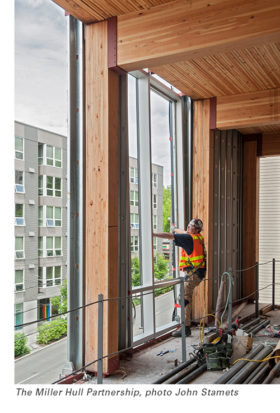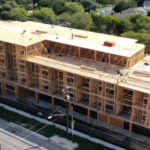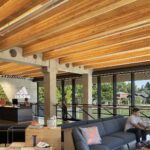Expert Tips
Availability of Redwood Glue-Laminated Timber (Glulam)
Guidance for designers seeking glulam members made from Redwood or other naturally-durable softwood species.

Glulam beams are made from a variety of wood species, most often softwood. This may include traditional softwoods such as Douglas-fir and Southern Pine, others such as Spruce/Pine/Fir and Hem-Fir, or naturally-durable species such as Alaskan Yellow Cedar and Port Orford Cedar. Hardwoods may also be used, but they’re less common and usually found in mixed-species lay-ups. Section 2.3 of the National Design Specification® for Wood Construction (NDS®) Supplement provides a list of glulam species groups, combinations, and abbreviations used in the design value tables.
Although uncommon and typically a custom order, Redwood may also be used in glulam beams in accordance with ANSI 117-2015: Standard Specification for Structural Glued Laminated Timber of Softwood Species, available from APA.
Reasons for wanting Redwood glulam may include:
- Durability (Redwood is a naturally-durable species) and appearance for outdoor canopy-type structures
- Durability and appearance for indoor pools
- Appearance for indoor use
Naturally-durable species have evolved to produce extractive compounds that protect the wood. These compounds are produced as the living ray cells in the inner sapwood zone die, forming the nonliving heartwood (center of the tree). As such, heartwood should be specified by designers wanting to use any naturally-durable species.
The degree of decay resistance also varies—among tree species, among individual trees, and within individual trees. Some naturally decay-resistant species also resist attack by insects and marine borers. Some are naturally resistant to fungal attack but have little or no protection against other organisms. Some may be resistant to one group of termites, but susceptible to others. Thus, natural durability against fungi, as well as resistance to insects or marine borers, can vary widely. To confirm performance under the intended exposure conditions, wood species should be evaluated against the hazards to which they will be exposed in the country of their use. Redwood is naturally resistant to both decay and termites.
Glulam stress classes for naturally-durable softwood species are as follows:
- Port Orford Cedar 22F-1.8E
- Alaska Yellow Cedar 20F-1.5E
- Western Red Cedar 16F-1.3E
- California Redwood 16F-1.1E
In addition to general information on structural glulam, ANSI 117-2015 includes the following information:
4.8 Grade Specific Requirements – California Redwood
Reference to this species herein applies to Redwood manufactured from timber grown within the Northern California coastal area as defined in the Standard Specifications for Grades of California Redwood Lumber of the Redwood Inspection Service. The design values shown herein are based on a statistical analysis of the growth characteristic of the lumber from this source.
Laminating lumber shall be of Redwood graded in accordance with the Standard Specifications for Grades of California Redwood Lumber of the Redwood Inspection Service.
There are five structural laminating grades of Redwood used for laminating purposes: “L1,” clear all heart laminating; “L2,” clear laminating; “L3,” select heart laminating; “L4,” construction heart laminating and “L5,” construction laminating. See above referenced standard for grading rules and specific requirements.
Additionally, Table A2, Reference Design Values for Structural Glued Laminated Softwood Timber, footnote (e)—notes reduction requirements for Redwood modulus of elasticity values:
(e) When Western Cedars, Western Cedars (North), Western Woods, and Redwood (open grain) are used in combinations for Softwood Species (SW), the design value for modulus of elasticity shall be reduced by 100,000 psi. When Coast Sitka Spruce, Coast Species, Western White Pine, and Eastern White Pine are used in combinations for Softwood Species (SW), the tabulated design value for shear parallel to grain Fvx and Fvy shall be reduced by 10 psi, before applying any other adjustment.
Information specific to Redwood can also be found in Table B1, Lay-up Requirements for Structural Glued Laminated Softwood Timber Combinations:

A designer wanting Redwood or other naturally-durable softwood glulam members where appearance or durability is of primary importance, would have to place a custom order. Consideration should be given to availability, durability and costs.
Photo: The Bullitt Center in Seattle, WA includes Douglas-fir glulam beams and columns and is certified to the highest benchmark of sustainability, the Living Building Challenge.


